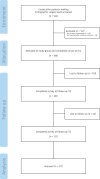Changes in patient-reported chief complaints with orthognathic surgery: a prospective cohort study
- PMID: 40694175
- PMCID: PMC12283525
- DOI: 10.1186/s40510-025-00572-4
Changes in patient-reported chief complaints with orthognathic surgery: a prospective cohort study
Abstract
Objective: There is a lack of studies on patient-reported outcomes in orthodontics. The aim of this study was to evaluate the changes in patient-reported chief complaints during orthognathic surgery treatment.
Materials and methods: Patients undergoing orthognathic surgery at the University Hospital Münster between 2019 and 2023 were eligible for inclusion in this prospective cohort study. Patient-reported chief complaints were recorded on visual analogue scale (VAS) forms before treatment ([Formula: see text]), and reevaluated after presurgical orthodontic treatment ([Formula: see text]), and 6-9 months after surgery ([Formula: see text]). Chief complaints were grouped into three main categories (pain, function, aesthetics) and ten subcategories, and their intensity was quantified over time.
Results: A total of 217 out of 386 recruited patients (56%) completed all study assessments and were included in the final analysis (female/male = 126/91, median age 24.1 years). Dental function, facial aesthetics, and dental aesthetics were the most frequently reported complaints at [Formula: see text]. At [Formula: see text], there was a statistically significant improvement in dental aesthetics. There was a statistically significant reduction in the intensity of each of the 10 subcategories from [Formula: see text] to [Formula: see text].
Conclusion: Orthognathic surgery patients most frequently report dental function, facial aesthetics, and dental aesthetics as their chief complaints, and these complaints were improved significantly after treatment.
Clinical relevance: The improvement in patient-reported chief complaints can be used to inform patients prior to treatment.
Keywords: Aesthetics; Chief complaint; Function; Malocclusion; Orthodontics; Orthognathic surgery; Pain; Patient-reported outcome; TMD; Temporomandibular disorder.
© 2025. The Author(s).
Conflict of interest statement
Declarations. Ethics approval and consent to participate: The study was conducted in accordance with the Declaration of Helsinki, and approved by the Ethics Commission of the Medical Faculty of the University of Münster, Germany (2019-334-f-S). Consent for publication: Informed consent was obtained from all participants in this study. Competing interests: The authors declare that they have no competing interests.
Figures



Similar articles
-
Masticatory function and temporomandibular disorders in patients with dentofacial deformities.Swed Dent J Suppl. 2013;(231):9-85. Swed Dent J Suppl. 2013. PMID: 24416880
-
The Use of Clear Aligners for Orthognathic Surgery: A Systematic Review.J Oral Maxillofac Surg. 2025 Jul;83(7):813-831. doi: 10.1016/j.joms.2025.03.009. Epub 2025 Mar 20. J Oral Maxillofac Surg. 2025. PMID: 40194551
-
Orthodontic treatment for prominent lower front teeth (Class III malocclusion) in children.Cochrane Database Syst Rev. 2024 Apr 10;4(4):CD003451. doi: 10.1002/14651858.CD003451.pub3. Cochrane Database Syst Rev. 2024. PMID: 38597341 Free PMC article.
-
Sexual Harassment and Prevention Training.2024 Mar 29. In: StatPearls [Internet]. Treasure Island (FL): StatPearls Publishing; 2025 Jan–. 2024 Mar 29. In: StatPearls [Internet]. Treasure Island (FL): StatPearls Publishing; 2025 Jan–. PMID: 36508513 Free Books & Documents.
-
WITHDRAWN: Dental fillings for the treatment of caries in the primary dentition.Cochrane Database Syst Rev. 2016 Oct 17;10(10):CD004483. doi: 10.1002/14651858.CD004483.pub3. Cochrane Database Syst Rev. 2016. PMID: 27748505 Free PMC article.
References
-
- Angle EH. Classification of malocclusion. Dent Cosm. 1899;41:350–7.
-
- Maspero C, Prevedello C, Giannini L, Galbiati G, Farronato G. Atypical swallowing: a review. Minerva Stomatol. 2014;63(6):217–27. - PubMed
-
- Doshi UH, Bhad-Patil WA. Speech defect and orthodontics: a contemporary review. Orthodontics (Chic). 2011;12(4):340–53. - PubMed
MeSH terms
LinkOut - more resources
Full Text Sources

